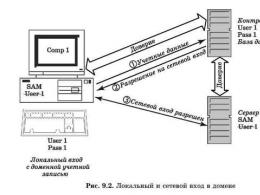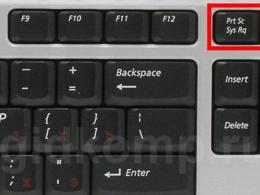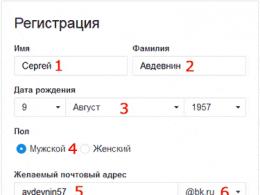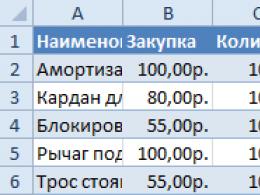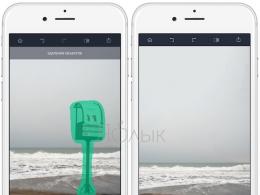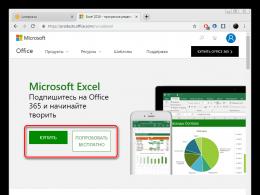Why the boot file is not transferred to the USB flash drive. The file does not fit on the flash drive what to do
Hello dear visitors. They asked me yesterday the question, they say, what to do, I can't upload a large file to a flash drive? The system says that there is not enough disk space, but there is enough space on the flash drive. It was necessary to copy a movie about 9 GB in size to a 16 GB flash drive. If you think logically, then everything should fit, but the system refused to upload such a large file to a USB flash drive and that's it.
I knew what was the matter, and while I was explaining what needs to be done, a bright idea appeared in my head that I should write about it on the blog, so I’m actually writing :). Let's first explain why large files, and to be precise, files larger than 4 GB do not want to be written to a USB flash drive and a message appears that there is not enough disk space.
The fact is that when you buy a USB flash drive, it is already formatted in the file system. FAT32, and the FAT32 file system does not support files larger than 4 GB. Here's the thing, it's very simple. We need to change the file system of the flash drive from FAT32 to NTFS. Because the NTFS file system supports, if I'm not mistaken, files up to 16 GB.
This issue is becoming more and more relevant every day, because the size of memory on flash drives is growing and they are getting cheaper every day. You can already buy a 16 GB flash drive for the same money that a year ago you could only buy 4 GB.
We just need to change the file system of our flash drive from FAT32 to NTFS. I will now write two ways in which this can be done.
Formatting a flash drive with the NTFS file system
A window will open in which we need to select the NTFS file system, select and click "Start". We agree to the system warning.
After the formatting process is completed, you will receive a blank flash drive with the NTFS file system, to which you can copy large files.
Converting a flash drive to NTFS for writing large files
The second method is a simple conversion of a flash drive to NTFS, this method essentially differs from the first one, only in that the files that you have on your flash drive will not be lost. But I still advise you not to take risks and copy the necessary files to your computer.
Our flash drive is connected and recognized by the computer. We go to "Start", "All programs", “Standard” and select “Run”. Or just press Win+R . A window will open in which we write the command cmd and click "Ok".
A window will open in which we need to register the command to convert the flash drive to NTFS:
convert k : /fs:ntfs /nosecurity /x
Where k is the letter that the computer assigned to your flash drive, go to "My computer" and see what letter you have. Enter this command and press "Enter".
After such a procedure, my files that were on the flash drive remained intact. That's all, this was the second way that you can make the flash drive accept large files.
And one more note, do not format the USB flash drive in NTFS format if you plan to use it as a bootable one, that is, you will install the operating system from it, by the way, I already wrote about that. Good luck!
Greetings, dear users! In my previous articles, I already wrote articles on the topic of USB storage media, namely, what needs to be done if, or another example, and important data for us remains on it, how to be in such a situation in order to recover data from a flash drive .
If you really do not know what to do in such situations, then I recommend that you read these articles. Since I started today's article with a conversation about flash media, today we will learn one more useful point regarding the flash drives themselves.
Imagine that you decide to write an image of some program or toy to your flash drive (by the way, I already wrote an article about what an image is, you can read more). Let's imagine that the volume of your flash drive is 16 GB, and your flash drive is absolutely empty and formatted. In turn, the volume of the recorded image is about 6 GB. At the moment when you try to write the image to a USB drive, a notification of this nature “Not enough disk space” appears. Agree that the appearance of a notification of this kind puts you in a kind of impasse, because the flash drive itself is completely empty and has 16 GB of free space.
And if we just copy a file with a volume of less than 4 GB to a USB drive, then in this case the file itself is successfully placed on the USB flash drive and no errors associated with lack of free space occur. The question arises, ?
At one time, I also had to deal with a similar phenomenon when a 5.7 GB file was not written to a removable disk, and another file of which was approximately 4.3 GB in size was written to a flash disk without any problems. So what is the actual problem then, you ask?
In this article, we will try to understand for what reason, files larger than 4-5 GB may not be written to your USB flash drive. Do you know why such large files are not written to a flash drive? In general, more and more often, many users who are faced with such a problem are asking questions: how to write a file larger than 4 GB to a flash drive. On the existing issue, I can tell you that I have heard different answers or, more precisely, arguments, arguments of users who have not encountered such a phenomenon before.
For example, on one of the forums, the user suggested the following answers: files are not written to the flash drive, because there is a virus there, which occupies the entire free disk space of the flash drive, or the flash drive is damaged or burnt out.
I will tell you that in such a situation, when files of large volumes (more than 4-5 GB) are not written to a USB flash drive, this does not mean at all that it is damaged, or there is some kind of virus or malware on it. And the reason for everything is the fact that the flash drive has a FAT32 file system.
By the way, I recommend you to read my article:
From here, you should remember once and for all that this file system is not able to support large volumes of files (more than 4-5 GB) for work.
Therefore, if you want files larger than 4 GB to be successfully copied to a USB drive and then used by you for a specific purpose, then in this case you first of all need a flash drive with the NTFS file system. It is generally said that the NTFS file system has the ability to contact such files, the volume of which can reach up to 16TB. From the above, it follows that in order to write a file larger than 4 GB to a USB flash drive, you will need a flash drive with the NTFS file system. You should not specially run to the first computer equipment store you come across to purchase such a flash drive.
I suggest that you go to the practical part of this article in order to visually consider how to convert the file system of your flash drive on your own. So, I hope, now it has become clear to you that we need to perform a number of necessary steps to create a flash drive with the NTFS file system.
In this article, we will consider several options that will allow you to convert the file system. Therefore, if you have difficulty copying large files, then this article will help you solve the problem.
First option:
So, after you have connected the flash drive to the computer, and the latter has successfully identified and recognized the USB drive, now you need to go to the properties of the removable device.
To do this, open "My Computer" and right-click on the removable device.

Select "Format" from the context menu that appears. As a result, a special window will open in which you will need to click on the drop-down menu in the "File system" line and select NTFS.
I draw your attention to the fact that if there are documents on your removable media, then they will need to be copied to your computer.

Then it remains only to click on the "Start" button. After a short time, the removable media will be formatted, after which the removable media will have the NTFS file system. However, one nuance should be noted here. If your computer is still using the Windows XP operating system, then in this case you will not be able to immediately format the USB flash drive in the NTFS file system.
In such a situation, you will need to open the "Device Manager" and select the value of removable media, and then, as shown in the figure below, you just have to go to the "Policy" tab to activate the corresponding parameter.
In conclusion, you should open the properties of the flash drive again and format it.

After the flash drive is formatted, do not forget to set the value of the parameter in the "Policy" tab to its original value.
Second Option:
The second option involves changing the file system of a removable device, due to the "Convert" operation.

To get started, you will need to launch the command line by clicking on the "Start" button and typing "cmd" in the search bar, followed by pressing "Enter".

Now in the window that opens, you should specify a special command that will perform the conversion of the file system of your flash drive. The command looks like this:
Then it remains to press "Enter". However, you should be aware that before converting a removable device, you will need to copy all the data to the hard drive, because you risk losing them.

I also draw your attention to the fact that you need to carefully enter the command and indicate the correct letter of your removable device. Otherwise, the conversion operation will not be performed and an error will appear indicating an invalid flash drive label.
At the end of this article, I would like to add that in addition to the above methods, they also resort to using various programs that also do a good job of changing the file system of a removable disk. However, if there are options for changing the file system that do not require software installation, then it is best to use these simple options, thereby not burdening your computer with installing unnecessary software.
For today, this is all I wanted to tell you about today in terms of data transfer via removable devices. Have you ever seen errors of this kind when copying a large file and wondered how to write a file larger than 4 GB to a USB flash drive? I hope today's article was useful for you. See you all in the next article, dear readers!
P.S Finally, I propose to watch a video cut of the meteorite fall on Chelyabinsk!
Sometimes problems can arise, as they say, from scratch. It is precisely such eccentricities that provoke a stupor among users, a lack of understanding of what caused the problem, and even more so, how to solve it.
A flash drive, which is currently the leader among removable drives, is often dumped with any content that is very important for a person’s professional activities, as well as in order to organize their free time in an interesting way.
Resetting a favorite movie is a piece of cake for many. What disappointment and incredible surprise arises when it suddenly turns out that files are not being copied to the USB flash drive.
At the same time, they begin to be even more surprised when they discover that one film is copied without problems, and the second simply refuses. It is for this reason that many people want to figure out why .
Problems with resetting content
In most cases, this problem occurs when the user is trying to dump a large file. Of course, many may object and say that for a large flash drive, a 4 GB volume can be negligible, but believe me, even this can act as the main reason.
Causes and troubleshooting
If you are having trouble copying a file to a flash drive, pay attention not so much to the size of your removable drive, but rather in what format it is accompanied.
In most cases, manufacturers format removable media in FAT16 or FAT32 format. In this case, no matter how much you try to change something, to force the video to be copied, the volume of which exceeds 4 GB, you will not succeed.
The fact is that such a file system does not support moving and saving large files. However, this does not mean at all that you have to lay down your hands and never achieve your goal.
Everything is solved, only you first have to format the USB flash drive in NTFS format. Right-click on it, select the "Format" option, and in the window that opens, select the NTFS format.

After this process is completed, repeat the process of copying a large video file. We are confident that this time what you have not been able to do before, will now succeed.
Of course, this is not the only cause of the problem. It may happen that there is simply no free space on the flash drive.
In this case, you should check the amount of filled volume and free volume. You can open "Computer", move the mouse pointer over the removable media icon, after which information regarding free space will appear.
You can also simply view this information by right-clicking on the media label and selecting the "Properties" option. A new window will open, in which the information of interest will be indicated and even demonstrated on a pie chart.

Viruses can block the process of copying content, so it does not interfere with checking the media with an antivirus program.
Sometimes the process of moving files is not possible on someone else's computer, but on others this problem does not occur. In this case, you can suspect incorrect settings on the PC when the ability to copy is prohibited by the system administrator of a particular PC.
And finally, you can check the flash drive for system errors on it. To do this, click the "Properties" parameter, go to the "Service" subsection and click "Perform verification" there.
So, such an unpleasant situation associated with the impossibility of copying, in most cases, can be solved by you yourself if you strictly follow all these recommendations.
Yesterday, a friend bought a new 16 GB flash drive and tried to copy a file to it, a little over 4 GB in size, to his surprise, the operating system notified that the file was too large for the final file system.
He tried to format it and copy the same file again, but without success. The fact is that by default, flash drives have the FAT32 file system, which allows you to transfer files only up to 4 GB. For example, a friend has a 16 GB flash drive, he could upload 4 3 GB files with "penny" or a bunch of "small" files to this flash drive. The problem is solved with three clicks. You just need to change the file system on the flash drive from FAT32 to NTFS. To do this, open MY COMPUTER, right-click on the flash drive, select Format...

In the window that appears, select the NTFS file system and click the START button.

The system will notify you that formatting will destroy all data on the flash drive . You need to click the [ OK ] button. Upon completion of formatting, you will receive a flash drive with the NTFS file system. After these simple manipulations, you can copy files larger than 4 GB to a USB flash drive.
If you already have some files on the flash drive and you do not want to format them, then you can do it a little differently, change the file system to NTFS using the command line. To do this, call the Run command by pressing the R key combination.

Good afternoon. We often use flash cards in everyday life. With the help, we transfer a huge amount of information, from films, photos, documents, to various programs. Copying to a USB flash drive is quite simple and convenient.
You all know that a larger USB flash drive can easily fit a smaller file. This is true, but not always. Quite often, users are faced with a situation where a person tries to copy a file twice as small in size to a flash card of a decent size, and he gets information that the disk size is not enough for copying.
Many people get scared and do not know what to do? Some people, at the same time, suspect that they slipped a smaller flash drive. But, most likely, the size of the USB drive is true.
How can this be? After all, this is contrary to logic? Absolutely true, but not quite. All files are written in a specific format. The flash drive format is most often FAT32. But, not all files are written in this format. There are quite a few file formats. Now we will not consider them.
Simply, I want to say that if a smaller file does not fit on it, then there is a reason for this. And, most often, it lies precisely in the formats.
The movie does not fit on a flash drive what to do
For example, you decide to copy a movie to a 32 GB flash drive. Let's say a 3D movie with a size of 14 GB. Or a backup copy of the system, as, for example, in my case. And it is very desirable to copy the backup copy to a USB flash drive, to restore the system from a backup copy in case of system failures (how to create a backup copy of the system
So, click on the shortcut "Computer", enter the explorer. Then, select the disk partition with our flash drive. My drive is F.


Click on it with the right mouse button and select "format".


We open data about our flash card: - Its capacity, file system, and so on. The file system will most likely be FAT32. Select NTFS by clicking on the triangle next to the file system.


Above the line "Formatting Methods", leave a checkmark "Quick". We do not need careful formatting now. Click "Press".
We are warned that formatting will destroy all information from our flash drive. We agree and click OK.


We are in the process of formatting. After that, we see that the formatting is completed.


We have changed the format. That's it, our 3D movie or backup will easily fit on our USB drive!
How to change the format of a flash drive without losing data
If you need to change the format of a flash card and, at the same time, save information on it, we will do it differently. We will work through the command line. For these purposes, Windows has the convert.exe utility.
So, we launch the command line by entering the cmd combination through the "Start", select cmd.exe, then right-click on this file, and select "Run" as administrator.


After system32 on the command line, enter
convert F: /FS:NTFS /nosecurity /x
Please note that you need to close the flash drive itself if you have it open.


where f is the symbol for the USB drive, yours may be completely different. Set your drive letter. We press Enter. You may see an inscription that the volume is being used by another process. In this case, we put y after yes / no (do not forget to put a space after the bracket).
We are starting to convert the disk to NTFS format. We have an inscription: - The transformation is completed. After the conversion is completed, close the command line. Our flash drive has changed the format and we have saved the information on it! Now, you can write the necessary data to it!
Important! Despite the fact that we are changing the format with saving data, just in case, before converting, copy the available information from the USB disk to the hard disk. During the conversion, unexpected failures may occur, and you may lose the data you need!
Now you know why the movie does not fit on a flash drive with a decent size and what to do in this case. Good luck!

